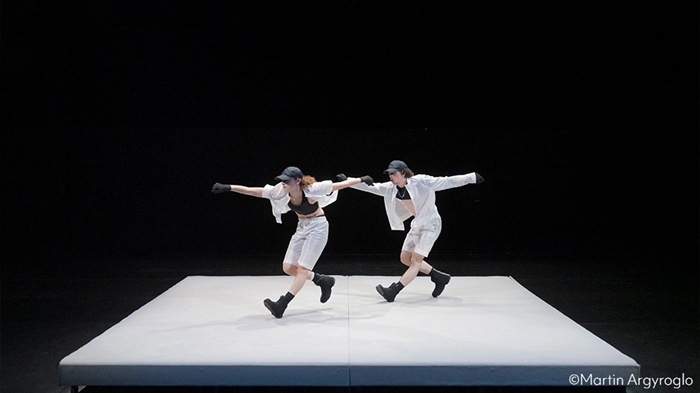MARCO DA SILVA FERREIRA
With its title borrowed from the lexical field of the piano, Fantasie minor emerged from the encounter with Chloé Robidoux and Anka Postic, young dancers from Caen. They have been dancing together since childhood, with a background in urban dance (hip-hop, dancehall, house), which played a role in their relationship and their development as individuals.
This piece responds to the proposal of the Centre Chorégraphique National de Caen en Normandie to imagine a work that can be performed in very different places: with an easily adaptable stage measuring 4 × 4 metres, Fantasie minor can be presented indoors or outdoors — in theatres or gardens, in public squares, and so on. The stage space imposes a constant proximity on the dancers, a factor they must navigate and negotiate.
This sharing of space between two people is also reflected in the music of the piece, Franz Schubert’s Fantasie in F minor, Op. 103 — a composition for piano four hands, in symmetry with the four feet of the dancers in this limited space.
Because they come from a culture of “battles” and “cyphers,” the two performers constantly reinvent their practice. There is something both fraternal and competitive between them, as if they were continuously responding to the logic of a game. These biographical elements, these youthful reminiscences, run through a choreographic composition inspired by the dances their bodies have studied. As I see it, Fantasie minor is a kind of rite of passage — an idea underscored by the Fantasie in F minor, the last piece composed by Schubert before his death at the age of 31, like a premonition of another rite of passage.
The dance engages with this composition through the illustrative approach that urban dances take to music. The performance begins in a virtuoso, almost conquering fashion, but as the choreography progresses, other sensibilities emerge. As if, beyond “conquering the stage and the audience,” the dancers were allowing themselves to feel or reveal a more fragile dimension. The music moves through moods that allow the performers to alternate between these two sensibilities. The hard-toed boots on their feet amplify these variations. Worn like ballet shoes throughout the piece, they give their figures a weightier and more grounded aspect. The duet is built around this contrast between the foot that strikes the ground with force and assurance and the almost crystalline piqué of classical ballet. Absurdity and virtuosity become a springboard for aesthetic, technical, and personal rediscovery.
— Marco da Silva Ferreira, September 2021
Free Admission
19.07 | 20.00 | 30'
Navarino Agora, Navarino Bay, Costa Navarino
Openings
Σχετικό περιεχόμενο χρηστών (UGC)
Ενημερωθείτε για ενδιαφέροντα θέματα γύρω από τον προορισμό μέσα από το περιεχόμενο των χρηστών μας
Newsletters
- About Us
- FAQ's
- Map
- Tourism Information Centers
- Disclaimer
- Sitemap
- Our Brand
- Media Room
- Add your Business
- Corporate
- MICE

Peloponnese. Greece beyond the obvious





Design and creation from Cosmote
Marinas and Moorings
Diving Centers
Get Inspired
- Media Gallery
- Peloponnese Travel Blog
- The Peloponnese in the Media
- Your Feedback
- Users' General Content
- Users' Local Products
- Users' Events Content
- Ask a Local
More
- My peloponnese vibe
- Our providers Network
- Destinations Map
- Weather
- Public Transport
- Frequently Asked Questions
- Useful Phones
- B2B
- Destination Statistical Data
- Contact

